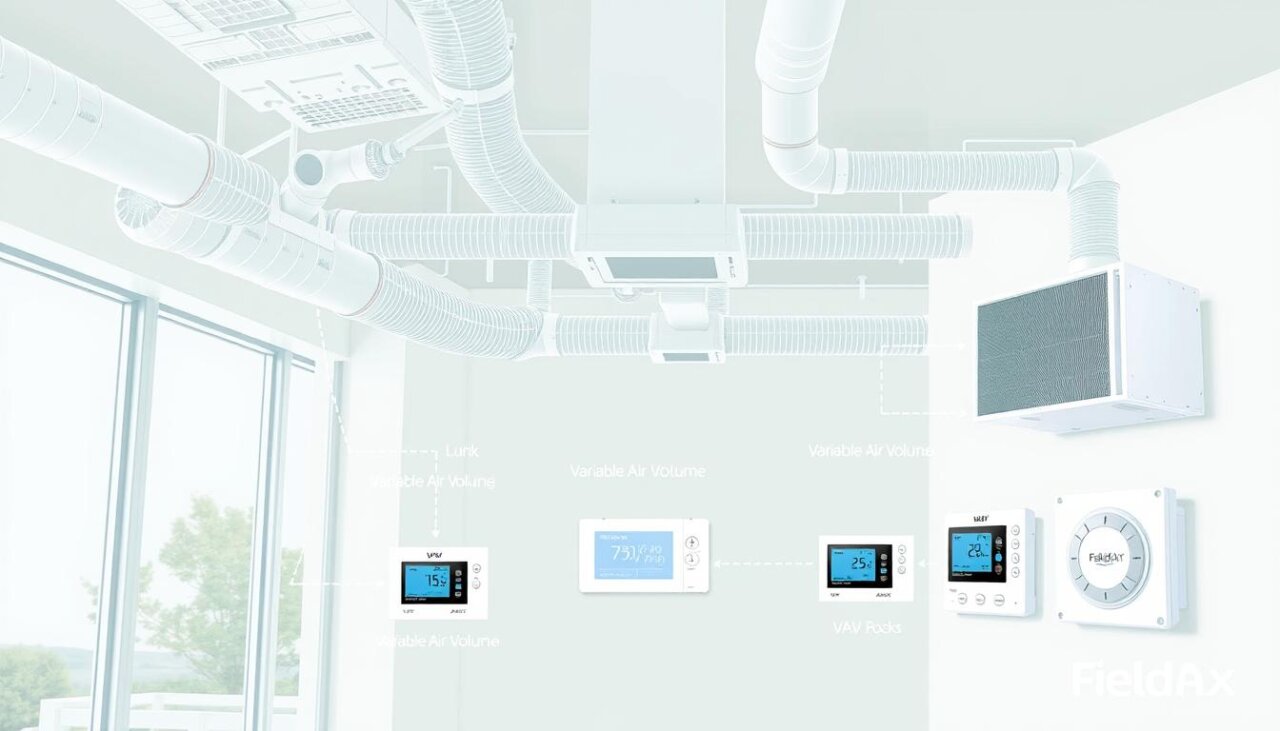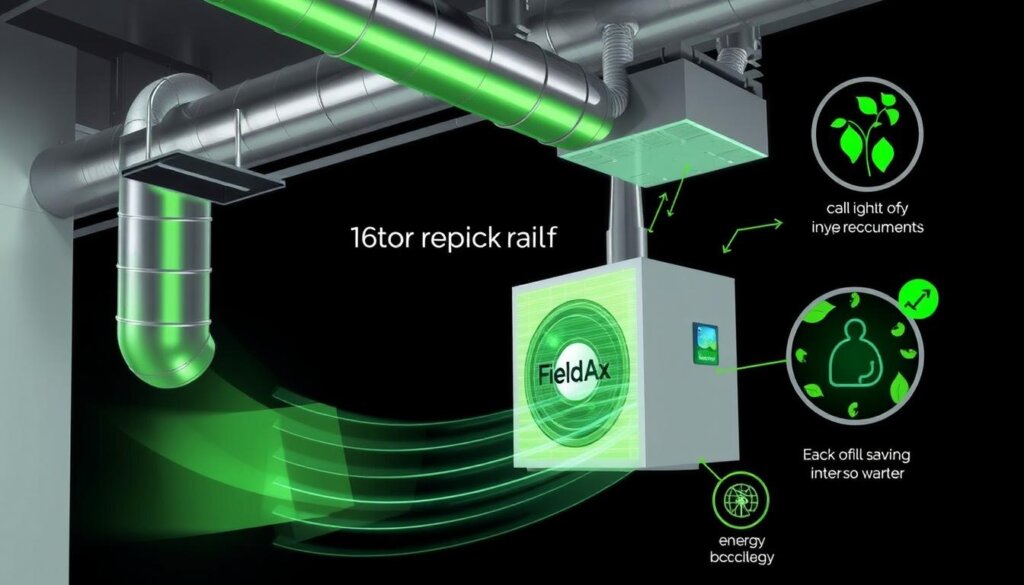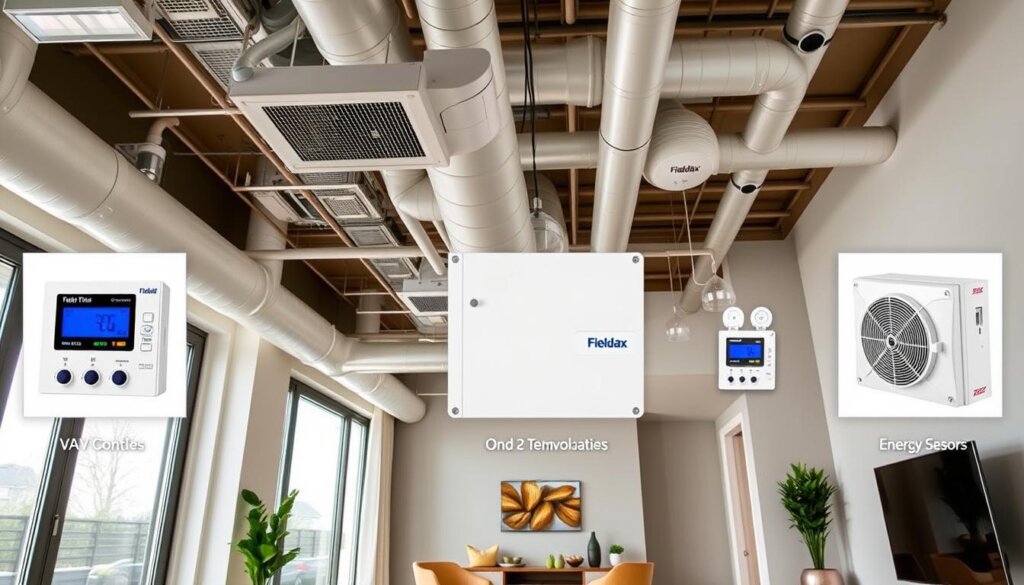As a homeowner, I often wonder how to make my home more energy-efficient. I also want to keep it comfortable. That’s when I learned about VAV, or Variable Air Volume, in HVAC systems. It seemed complex at first, but it’s actually very helpful for both heating and cooling.
VAV systems adjust the air flow based on what each room needs. This is different from traditional systems that always send the same amount of air. I found out that VAV systems can save a lot of energy. Plus, tools like HVAC Service Software make managing these systems easier.
Learning about VAV is key for anyone wanting to improve their home’s heating and cooling. It also helps lower energy costs.

Key Takeaways
- VAV systems adjust air volume based on real-time needs, promoting energy efficiency.
- Almost half of consumers prioritize energy efficiency when purchasing appliances.
- Unlike CAV systems, VAV systems prevent paying for unnecessary heating or cooling.
- Better energy savings can significantly lower maintenance costs over time.
- VAV systems provide customized temperature control for different zones, enhancing comfort.
- These systems offer flexibility for future modifications and new installations.
Understanding VAV Systems
VAV systems, short for Variable Air Volume systems, adjust airflow based on heating and cooling needs. They differ from traditional HVAC systems that keep airflow constant. VAV systems offer tailored temperature control, which is key in areas needing different temperatures.
These systems have multiple VAV boxes connected to a central air handler. As a homeowner, I’ve found this setup improves airflow control and energy efficiency. With rising energy costs, VAV systems in homes are becoming more popular. They boost comfort and cut down on energy waste, fitting well with green living.
Learning about VAV systems helps homeowners choose better HVAC strategies. With precise control, I keep each room comfy without wasting energy. It’s important to value efficient heating and cooling, especially to save money and protect the environment.
How VAV Works in HVAC
A Variable Air Volume (VAV) system is key in today’s HVAC. It uses a smart way to heat and cool. Each part works together to control the climate inside. This makes places more comfortable and saves energy.
Components of a VAV System
The main parts of a VAV system are the central air handler, VAV boxes, thermostats, and ductwork. The central air handler cools or heats the air. Then, it sends it through the ducts.
VAV boxes control the air flow to each area. They adjust based on the temperature needed. Each zone has a thermostat that talks to its VAV box. This lets them adjust the air flow just right.
Airflow Control Mechanism
The airflow control in VAV systems helps save energy. It lets each area get just the right amount of air. This keeps the temperature right and cuts down on costs.
Using HVAC Service Software makes it even better. It lets you watch and adjust the system in real time. This shows how important airflow control and energy-saving tech are in HVAC today.
Benefits of VAV Systems
VAV systems offer many advantages in today’s HVAC world. They help homeowners and facility managers make smart choices for their heating and cooling needs.
Energy Efficiency Improvements
One key VAV benefit is their energy efficiency. They use less energy than traditional systems by adjusting airflow as needed. This leads to lower bills and big savings on utilities.
Getting the right size for VAV systems is important. It helps avoid problems and keeps costs down. Some HVAC software lets you monitor energy use, making it easier to save.
Enhanced Comfort Levels
VAV systems provide better temperature control, making people happier. They let each area be set to its own temperature, improving comfort. This makes spaces more comfortable and productive.
They also help keep air quality good. This makes the indoor environment better for everyone.
Longer Equipment Lifespan
VAV systems make HVAC equipment last longer, saving on maintenance costs. They work harder for less, leading to fewer repairs and replacements. Using HVAC technician software helps keep them running well.
So, VAV systems are a smart choice for comfort and saving money in the long run.

Comparing VAV and CAV Systems
VAV (Variable Air Volume) and CAV (Constant Air Volume) systems differ in how they manage airflow. VAV systems adjust air supply based on each zone’s needs. This makes them more energy-efficient by only using the air needed.
CAV systems, on the other hand, always send the same amount of air. This can lead to over-heating or over-cooling in areas that don’t need it.
Energy efficiency is key for many consumers when buying HVAC systems. VAV systems cost more upfront but save money on energy bills over time. They offer *tailored temperature control*, which means lower utility costs and more comfort in each area.
CAV systems might be cheaper at first but use more energy overall. This is because they can’t adjust air delivery as needed.
VAV systems help the environment by using less energy. Buildings are a big source of CO2 emissions, making VAV systems important. To get the most out of a VAV system, it needs proper setup and maintenance.
Getting the sizing right, balancing airflow, and placing thermostats correctly are crucial. These steps can greatly improve performance and save money. Using advanced controls to prevent reverse airflow can save even more energy.
Businesses that choose energy-efficient VAV systems can attract more customers. This can lead to happier clients and stronger relationships. VAV systems are a sustainable choice that can boost productivity and resource management.
Knowing the differences between VAV and CAV systems helps make better choices for HVAC investments.
Installation and Maintenance Considerations
Getting VAV installation right is key for top-notch heating and cooling. Knowing the best ways to install will make your system work better and last longer. Important steps include the right size for parts, balanced airflow, and the right spot for thermostats.
Installation Best Practices
Using the best methods for VAV installation means a better system. It’s important to look at the building’s layout to avoid airflow problems. Making sure ducts are the right size helps air flow right. Getting pros to install it helps avoid mistakes and follows rules, saving energy.
Maintenance Tips for VAV Systems
Keeping VAV systems in good shape is crucial. Using HVAC maintenance software makes it easy to schedule checks and manage tasks. HVAC technician software helps with VAV box settings and checks performance, catching problems early. This keeps your system running smoothly, saving time and keeping you comfortable.
Common Applications of VAV Systems
VAV systems are used in both homes and commercial buildings. They are known for their flexibility and ability to save energy. These systems do more than just keep us comfortable; they also help manage energy use in different settings.
Residential Use Cases
In homes, VAV systems adjust the temperature in each area. This is great for houses with multiple floors or changing numbers of people. Each room can have its own temperature, making it more comfortable and saving energy.
By using VAV technology, heating and cooling systems become more precise. They meet the specific needs of each area, improving comfort and energy efficiency.
Commercial Building Benefits
In commercial buildings, VAV systems offer big advantages. They allow for customized climate control, which boosts employee happiness and productivity. By adjusting airflow, these systems help meet both comfort and sustainability goals.
These systems can be easily adjusted to fit the needs of businesses. This flexibility ensures that HVAC solutions grow with the company, keeping energy use low over time. Investing in VAV technology is key for businesses looking to be more environmentally friendly.

Impact of HVAC Service Software on VAV Systems
Using a strong HVAC service software greatly improves VAV system management. It offers real-time monitoring and analytics through predictive maintenance. This means technicians get alerts fast, fixing small issues before they get big.
This quick action is key to keeping VAV systems running well. It’s all about being proactive.
Energy efficiency also gets a boost. The software helps make decisions based on data, leading to smarter energy use. It spots where energy can be cut down, saving money and helping the planet.
Getting HVAC service software is a smart move for keeping equipment running longer. It makes sure maintenance is done on time, reducing damage. This leads to a better workflow, higher service quality, and happier clients.
Choosing the Right HVAC System for Your Home
When I start looking for HVAC systems, I consider a few key things. I think about the size of my home and how much energy it uses. This helps me find the best HVAC solutions for my space.
I also look into the benefits of VAV systems. They offer zone control and better energy use. This means I can have the right temperature in each area of my home.
Using HVAC scheduling software is another big plus. It lets me plan when my system runs based on who’s home. This way, I use less energy and save money over time.
Talking to HVAC experts is also a must. They give me advice on what to choose and how it will work. This ensures my system meets all my heating and cooling needs.
Future Trends in VAV Technology
The future of VAV technology is bright, thanks to smart HVAC systems and IoT. These advancements help create more efficient systems. They can analyze data in real-time to work better automatically.
This means better energy use and more precise climate control. Homes and businesses will get the exact temperature they need.
IoT is getting better, and soon we’ll see remote monitoring and control in HVAC. This lets users adjust their heating and cooling with smart devices. It’s a big step towards better energy use, making systems smarter and more flexible.
Energy efficiency is key in the future of VAV technology. It will help meet global sustainability goals. Smart HVAC systems are crucial for this change. They will bring smarter, more efficient heating and cooling to all.
Conclusion
Understanding Variable Air Volume (VAV) systems can change how I heat and cool my home. These systems adjust airflow to fit different areas, making my home more comfortable. They also save energy, which means lower bills.
Using HVAC service software with VAV systems helps me keep them running well. This means they last longer and cost less to maintain. Knowing about VAV systems and how to manage them helps me make better choices for my home.
Learning about VAV technology improves my home comfort and helps me save energy. Investing in these systems could make my home more eco-friendly. This change would have a big, positive effect on my life and home.
See how FieldAx can transform your Field Operations.
Try it today! Book Demo
You are one click away from your customized FieldAx Demo!
FAQ
What is a VAV system in HVAC?
A VAV system adjusts air flow based on area needs. It makes buildings more comfortable and energy-efficient. This is better than systems that always send the same amount of air.
How do VAV systems improve energy efficiency?
VAV systems adjust air flow as needed. This cuts down on energy waste and lowers costs. They are great for places with changing heating and cooling needs.
What are the main components of a VAV system?
A VAV system has a central air handler, VAV boxes, thermostats, and ductwork. These parts work together to control air flow and keep temperatures right in different zones.
Why should I consider VAV systems for my home?
VAV systems let you control each zone separately. This means you can make your home just how you like it. It also saves on energy costs.
What is the difference between VAV and CAV systems?
VAV systems change air flow based on zone needs. CAV systems always send the same amount of air. VAV is more energy-efficient because it only uses what’s needed.
How can I maintain a VAV system?
To keep a VAV system running well, calibrate VAV boxes regularly. Use HVAC maintenance software for check-ups. Make sure air flows evenly in ducts.
Where are VAV systems commonly used?
VAV systems are in homes for better temperature control. They’re also in commercial buildings. They help control climate, improve comfort, and cut energy costs.
What is the role of HVAC Service Software in managing VAV systems?
HVAC Service Software helps manage VAV systems. It offers predictive maintenance and real-time data. This boosts energy efficiency and extends system life.
What factors should I consider when choosing an HVAC system?
Think about your home’s size, energy use, and comfort needs. Consider VAV systems and how HVAC software can save energy based on when people are home.
What trends are shaping the future of VAV technology?
Future trends include smarter HVAC systems and IoT integration. These advancements allow for better performance and remote monitoring. They improve energy use and user control.
Author Bio
Co-Founder & CMO at Merfantz Technologies Pvt Ltd | Marketing Manager for FieldAx Field Service Software | Salesforce All-Star Ranger and Community Contributor | Salesforce Content Creation for Knowledge Sharing






